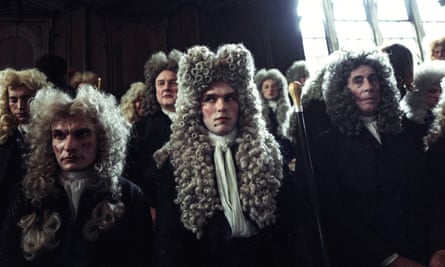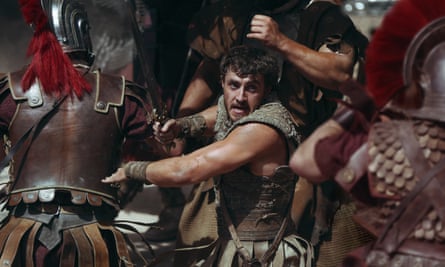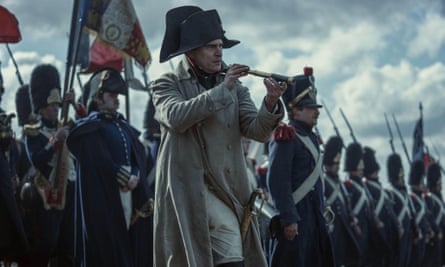If we set aside the more glaring historical inaccuracies in the trailers for the long-awaited Gladiator sequel – the guy riding a rhinoceros for example – there were early signs that its director Ridley Scott remained committed to one of the first film’s more subtle flaws.
They are there in the posters, if you know where to look, and they feature throughout the film itself, which hits cinemas this week with Paul Mescal in the leading role. We’re talking about the leather wrist guards.
“I’m afraid leather forearm bracers have nothing to do with ancient Rome,” says Alexander Mariotti, a historian and specialist in gladiatorial combat who worked as a researcher and script consultant on the new film. “They don’t appear in any imagery or sources … they just look good on film.”
And so, just as Russell Crowe wore some heavy duty wrist-strapping as Maximus Decimus Meridius in the 2000 blockbuster, so does Mescal in his turn as the first gladiator’s even beefier son, Lucius Verus (who, sure enough, is also forced into slavery and becomes a gladiator).
Mariotti, who is based in Rome and London, says the arm armour is closer to something that medieval archers might have worn. Yet it has appeared in almost every screen representation of fighty Romans since Ben Hur (the silent 1907 one). He thinks early costume departments may have taken inspiration from neoclassical depictions of Rome.
 View image in fullscreen
View image in fullscreen
The ubiquity of the accessories reveals much about the way Hollywood flirts with verisimilitude and shapes popular historical understanding, even while consultants are in growing demand. Their role can vary, from early development advice up to script reviews and seats on set.
Film-makers say: Is this accurate? And you’ll say: Absolutely not. And then they’ll do it anywayAlexander Mariotti
As well as dutifully pointing out anachronistic wristwear and incongruous rhinos, Mariotti advised Scott on the use of weapons and language. He hasn’t yet seen the film but was heartened to see in the trailer the line “Ubi tu ibi ego” (“Wherever you are I will be”), a Latin marriage vow that he suggested, and which is inscribed in his own wife’s wedding ring.
Consultants are called on even when inaccuracy is a feature rather than a bug. Amanda Vickery, a professor of early modern history at Queen Mary, University of London, was a Bridgerton fan before her colleague, Hannah Greig, asked her to take over consulting duties for the third series of the Netflix Regency hit, which has been described by its own makers as “definitely a fantasy”.
 View image in fullscreen
View image in fullscreen
“The mantra Hannah had, which I agree with, is that producers want to make choices, not mistakes,” says Vickery, who binged the first series of the show with her daughters. “The job of the adviser is to give them that information, but it’s their job to make a hit show.”
Vickery became involved at the script stage, filling margins with notes as password-protected drafts arrived from production company Shondaland. In one script a character admired some cerulean blue silk. “And I was able to say, well, cerulean dye wasn’t invented by then, just change it to French navy or azure, and it was changed,” Vickery says. “Little details that might obtrude are very easy to correct because you’re not spoiling the flow.” Vickery also spent time on set, and once prompted the reshoot of a scene in which a male character left a young debutante during a dance without a formal farewell. The historian scoffs when I ask if such insight is well paid. “Are you mad?! I’m not a lawyer, none of this is lucrative,” she says.
Ridley Scott is rather Napoleonic himself. There’s no doubt when he comes into a room who’s in chargeMichel Broers
Consultants quickly learn to bite their tongues when more significant corrections or queries are left in the margins. Michael Broers, a professor of western European history at the University of Oxford, was about to retire when he was summoned to a meeting with Ridley Scott. The director had read Broers’ books about Napoleon, and wanted to consult him for his biopic, which came out last year with Joaquin Phoenix in the titular role.
“He’s rather Napoleonic himself,” Broers tells me of Scott, laughing. “There’s no doubt when he comes into a room who’s in charge, and pretty soon I became fully aware that we were making a movie, not a documentary.”
Scott had already filmed a now notorious scene in which Napoleon’s troops blow the tops of the Egyptian pyramids with cannon, in an explosive revision of Napoleon’s very real capture of Cairo. “When he explained that he had done this, I was aghast,” Broers says. “That didn’t happen, I told him, and nothing like it happened. He said: ‘Come on, just sit down and watch it.’”
 View image in fullscreen
View image in fullscreen
When Broers watched the scene, he burst out laughing. “I said I thought it was the funniest thing I’d ever seen. ‘Well, then, it’s staying in, isn’t it?’ [Scott] said. I think if he’d simply invented the Battle of the Pyramids, which did happen, that would have been different.”
Broers likens the role of the historical consultant to that of a father confessor: “You’re there to tell him he’s sinned, and he wants to know that he’s sinned, but you know he’s not going to change his ways.” But the historian’s pragmatism wasn’t always shared when an increasingly busy online community of factcheckers scrutinised Napoleon.
Most prominently, Dan Snow posted a TikTok breakdown of Scott’s truth-stretching, including the pyramid attack. The director’s response in an interview last November: “Get a life.” But I gather the 86-year-old Scott was privately fuming. An insider on Gladiator II, which had just started filming when Napoleon was released, tells me that, in response, Scott banned historical consultants from the set. (Neither the director’s production company nor Paramount, the studio behind the film, comments on the claim when I put it to them.)
skip past newsletter promotionSign up to Inside Saturday
The only way to get a look behind the scenes of the Saturday magazine. Sign up to get the inside story from our top writers as well as all the must-read articles and columns, delivered to your inbox every weekend.
after newsletter promotion
It’s not Scott’s first clash with historians. Kathleen Coleman, head of classics at Harvard, was so appalled by the first Gladiator movie that she asked for her consultant credit to be removed. She claimed that in one message from the production office she was asked to find evidence to show that female gladiators attached razor blades to their busts. “Scholars are, of course, notorious for being obsessed with detail … but detail is the repository of authenticity,” Coleman later wrote in an essay called The Pedant Goes to Hollywood.
 View image in fullscreen
View image in fullscreen
Scott revels in disregarding such detail. “This is the first coffee bar in Roman history,” he reportedly boasted after the first film came out, when one pedant pointed out pavement cafes weren’t a thing in ancient Rome. (The new film goes further, featuring a noble reading a newspaper at a cafe, 1,200 years before the invention of the printing press.) But Broers shares Scott’s sentiment, and was amused by the historical inaccuracies in one viral nitpicker’s video (he prefers not to say whose). “It’s a movie! What do you want to sit down and watch here?” he says. The historian recalls moments in script meetings when it was Scott’s turn to be aghast. He’d turn and say to me, ‘What did happen?’ and nine times out of 10 I’d tell him and his jaw would drop,” he says. Truth is stranger than fiction and sometimes it was even too much for him.”
More quotidian truths can jar on screen; Mariotti says that the first Gladiator originally had a scene in which Russell Crowe’s character endorses an olive oil brand in the Colosseum. “And they said: ‘No one’s ever going to believe that, it’s stupid,’ and they cut it, but it was historically correct,” he says.
Actors often call on consultants to help flesh out their roles. “Alicia Vikander phoned me when she wanted to add her own prayer to the script,” says Peter Wagstaff, a classical musician and amateur historian who started SceneSpan, a consultancy for historical film and TV, when a friend in the industry said there was a shortage of advisers. Vikander was starring as Katherine Parr alongside Jude Law as Henry VIII in Firebrand, which charts the end of the king’s reign, and wanted to check that the prayer rang true (it did). On the same set, Erin Doherty, who plays Anne Askew, the doomed Protestant poet and preacher, wanted to learn more about her character’s religious convictions. “She wanted to get into the mindset of someone who believed so fervently in the Bible in English that she would die for it,” says Wagstaff, whose work has ranged from a Cadbury’s ad with a Victorian setting to the upcoming new series of Wolf Hall, in which he also has a singing role in a choral scene.
Mariotti, Vickery and Broers all say that they have come away from brushes with Hollywood feeling enriched rather than abused. Vickery took her experiences to a history master’s course she teaches, part of which considers how society engages with history itself. In Bridgerton, she sees no contradiction in a show that seeks accuracy in shades of blue while at the same time adapting Coldplay’s Yellow as a wedding march.
“That’s what’s interesting about what Shonda Rhimes has pulled off,” she says. “She’s finding a new audience for Regency drama while having enough there to hold the old audience for costume drama.”
Sometimes a creative licence can serve history, Vickery adds. She admires The Favourite, the 2018 satirical period comedy about the court of Queen Anne. “All the women are soberly dressed and the men are floridly dressed, which wouldn’t have been the case,” she says. “But the costumes are making a point about where power lies, with the men as decorative. The film approaches a historical truth by breaking the rules.”
Mariotti has absorbed time on elaborate sets into his lectures. “Suddenly, after spending years studying ruins, I was walking on the cobbled streets of the Via Sacra, looking at the Temple of Jupiter,” he says of his first consulting role, on the 2007 HBO series Rome. “I found that when I was giving lectures, I was able to do it more vividly because I’d seen these images.”
The real Colosseum might not have featured rhinos or wrist guards, but Mariotti sees parallels between Hollywood movies and the theatrical staging that was often central to shows in ancient Rome. “When you sat in the Colosseum and you watched trees pop out of the ground as they transformed the arena into a jungle, it wasn’t really what a jungle looked like,” he says. “But it didn’t matter, because it was entertainment.”
Gladiator II is in cinemas now.
∎
